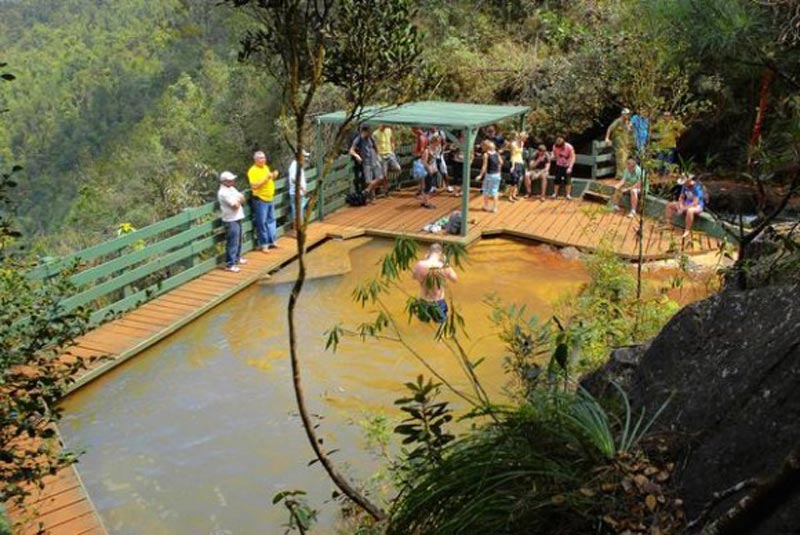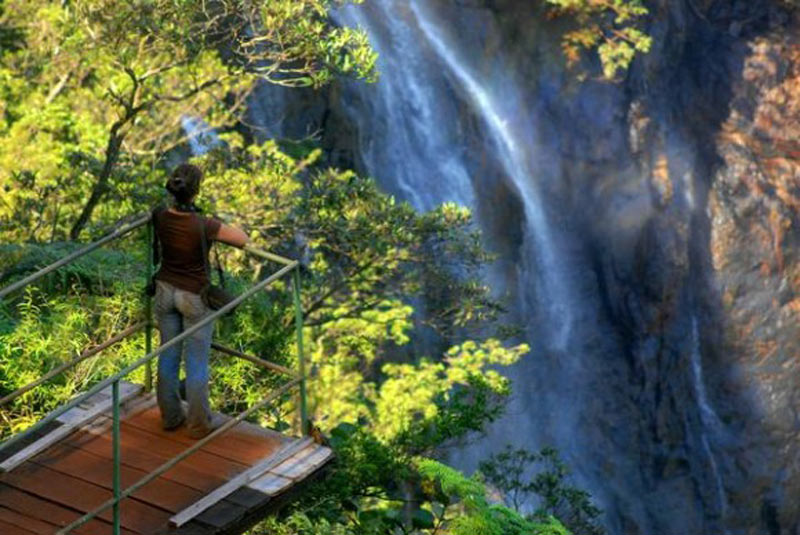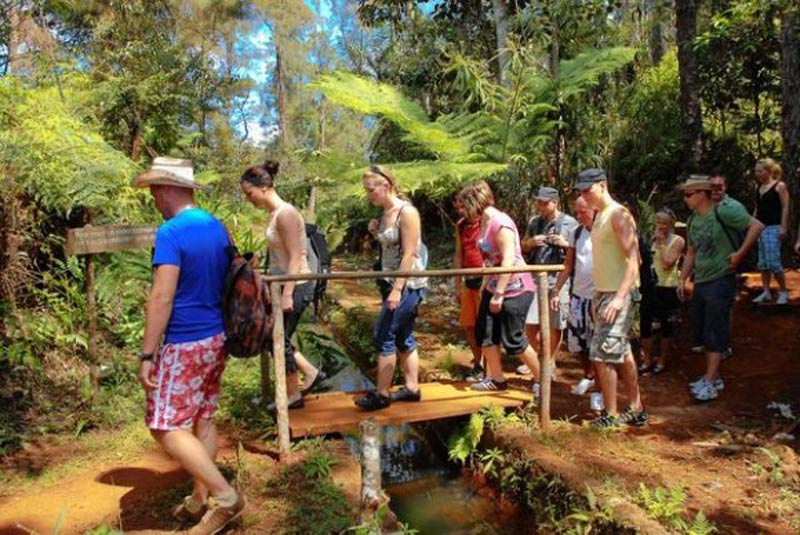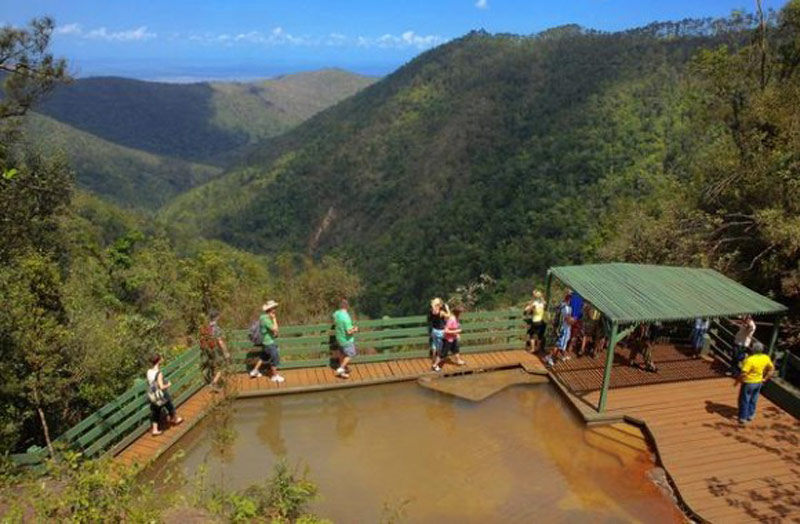Tourism in Cuba: More than Sun and Sea
- Written by Gremán Veloz Placencia
- Published in Holguin
- Hits: 6473
 Photos: Juan Pablo Carreras / ACNThe second most popular natural tourist destination in Cuba is the Salto de Guayabo, an impressive vertical waterfall with two drops of 85 and 127 meters, located in the municipality of Mayari, Holguin province.
Photos: Juan Pablo Carreras / ACNThe second most popular natural tourist destination in Cuba is the Salto de Guayabo, an impressive vertical waterfall with two drops of 85 and 127 meters, located in the municipality of Mayari, Holguin province. Those who visit the site, near Mensura-Piloto National Park, consider it fascinating, since in addition to being one of the highest in the country and boasting crystal clear waters, it provides an enjoyably cool microclimate, produced by balanced temperature and humidity.
Located in the waterfall's surroundings are 36 orchid species and 33 types of ferns, reflecting the area's rich plant life, accompanied by equally prolific fauna, including many birds.
 Along the path leading down to the pool formed by the impact of the water, visitors can appreciate the height of the falls and also the recently updated service facilities, as did tour operators, travel agents and nature lovers from many nations who attended the 9th International Nature Tourism Event, Turnat 2017, held last September, with activities at several locations in the provinces of Holguin and Guantanamo.
Along the path leading down to the pool formed by the impact of the water, visitors can appreciate the height of the falls and also the recently updated service facilities, as did tour operators, travel agents and nature lovers from many nations who attended the 9th International Nature Tourism Event, Turnat 2017, held last September, with activities at several locations in the provinces of Holguin and Guantanamo.The international gathering provided an ideal opportunity to confirm that Holguin is a province with much potential in this arena, beyond the many popular beach resorts, predominate before 2015, according to Manuel German Menendez Perez, specialist at the Research, Development, Development, and Innovation Tourism Training Center, affiliated with the Ministry of Tourism provincial office.
"A bit more than two years ago, the strategy for the development of nature tourism was launched in Holguin, containing as an essential element, the Sustainable Tourism Development Program of the province's protected areas system, that includes 16 sites."
Of these, he explained, ten can be utilized for eco-tourism (hiking, bird-watching, cycling, horseback riding, and camping), as well as adventure tourism including jeep safaris, caving, kayaking, and climbing.
"We also evaluated the potential of farms where it would be possible to promote and develop the possibilities of rural tourism, that would allow for interaction with the lifestyles of people in the country; as well as agro-tourism, that would involve sharing agricultural work with the farmer," he said.
One special characteristic of Holguin is that two national parks are located her adjacently - the Mensura-Piloto and Pico Cristal - in addition to a portion of the Alejandro de Humboldt World Heritage Site, under the jurisdiction of Guantanamo province.
Open now, within the portion of Humboldt National Park in Holguin, is the Farallones de Moa Cave Trail, that provides access to a natural four kilometer long cavity, which has enchanted visitors with its majesty and the river that flows through it in continuous, small waterfalls.
Mensura-Piloto National Park features the Sabina trail, which attracts hiking enthusiasts who enjoy observing plant and animal life, as they make their way over the rolling hills to the Poza Rafael, where a refreshing dip in cool waters awaits them.
Another trail facilitates exploration of the Fría Cave, notable for its creation by the Chivera river that flowed over the rock for years, producing one of the area's most interesting geological formations.
 The Nature, Adventure, and Rural Tourism technical sub-group is the multi-disciplinary entity currently working on the preparation of a portfolio outlining potential projects in Pico Cristal National Park, which contains Cuba's fifth highest mountain peak.
The Nature, Adventure, and Rural Tourism technical sub-group is the multi-disciplinary entity currently working on the preparation of a portfolio outlining potential projects in Pico Cristal National Park, which contains Cuba's fifth highest mountain peak."This area is the main headwaters of the province's northwestern network of rivers. Here ground covering vegetation can be observed, that is woods, pine forests, and charrascos, with abundant wildlife, and the potential to promote bird-watching.
There are also signs showing that the area is inhabited by the almiquí, a living fossil," Menéndez explains.
The holding of Turnat 2017 in the region led to the launching of a tour route entitled the Holguin Countryside Grand Adventure, departing from the province's beach resorts (Pesquero, Yuraguanal, Esmeralda and Guardalavaca), to rural settlements and farms, the shady coffee plantations of Pinares de Mayari, with a final stop at coffee and cacao farming areas in Farallones de Moa.
The event also led to the organization of the Columbus route, a seven day tour to sites identified by the admiral in his diary, crossing the current province of Holguin during his first journey to Cuba.
Other tempting offers on the flatlands exist, as well. Among outstanding natural elements in protected areas are the Karst Hills of Maniabón, near the camping site of La Silla de Gibara, where the Tinajitas trail is found; while located within the Naranjo Bay protected area are the Rocazul ecological park and two trails, the Loma del Templo and Las Guana.
Among the ideal areas for adventure tourism is the Caletones Ecological Preserve, in the municipality of Gibara, with its star attraction, cave diving at the Tanque Azul, a flooded cavity often called a cenote.
 To date, nature tourism options have been offered as additional activities to those enjoying the beach at resorts along the province's coastline, Menéndez said. He noted that this implies the challenge of stabilizing this type of commercialization, taking action to make these activities regular options for clients, nature lovers, and environmentalists, and marketing them directly to tour operators and travel agents specializing in nature tourism.
To date, nature tourism options have been offered as additional activities to those enjoying the beach at resorts along the province's coastline, Menéndez said. He noted that this implies the challenge of stabilizing this type of commercialization, taking action to make these activities regular options for clients, nature lovers, and environmentalists, and marketing them directly to tour operators and travel agents specializing in nature tourism.MSc. Norelis Peña Peña, environmental management specialist with the Ministry of Science, Environment and Technology, Citma, in Holguín, and leader of a research project on the development of sustainable tourism in protected areas in the province, has identified complex challenges like those that appear in the sales process, for which the leisure industry is responsible.
Among the weaknesses she identified were the under-utilization of natural and cultural assets; insufficient eco-tourism offerings; limited availability of infrastructure; poor supervision of visitors and their environmental impact; low levels of investment in improving quality of life for local communities; as well as inadequate conservation and maintenance of sites.
Needed is a comprehensive approach that facilitates coordinated work by all persons and entities involved in promoting the enjoyment of beautiful natural areas which have become attractive tourist destinations, she noted.
MINISTRY EFFORTS
With the goal of expanding extra-hotel activity in Cuba, the Ministry of Tourism (Mintur) has included new projects in its portfolio of foreign investment opportunities, to develop entertainment, recreational activities, and adventure tourism.
Included for the first time in this portfolio are the construction of two natural adventure parks, one located in Canasí (near Santa Cruz del Norte, in Mayabeque province), and another in Bahía de Naranjo (Holguin).
Among Mintur's priorities is diversifying tourist offerings beyond sun and sand vacations at resort hotels, positioning Cuba as a destination in the international market to accelerate the development of tourism, the national economy's second most important source of income.
Foreign investment is fundamental to the country's socio-economic progress, and the most recently updated portfolio of opportunities for investors includes 140 tourism projects. / Granma
